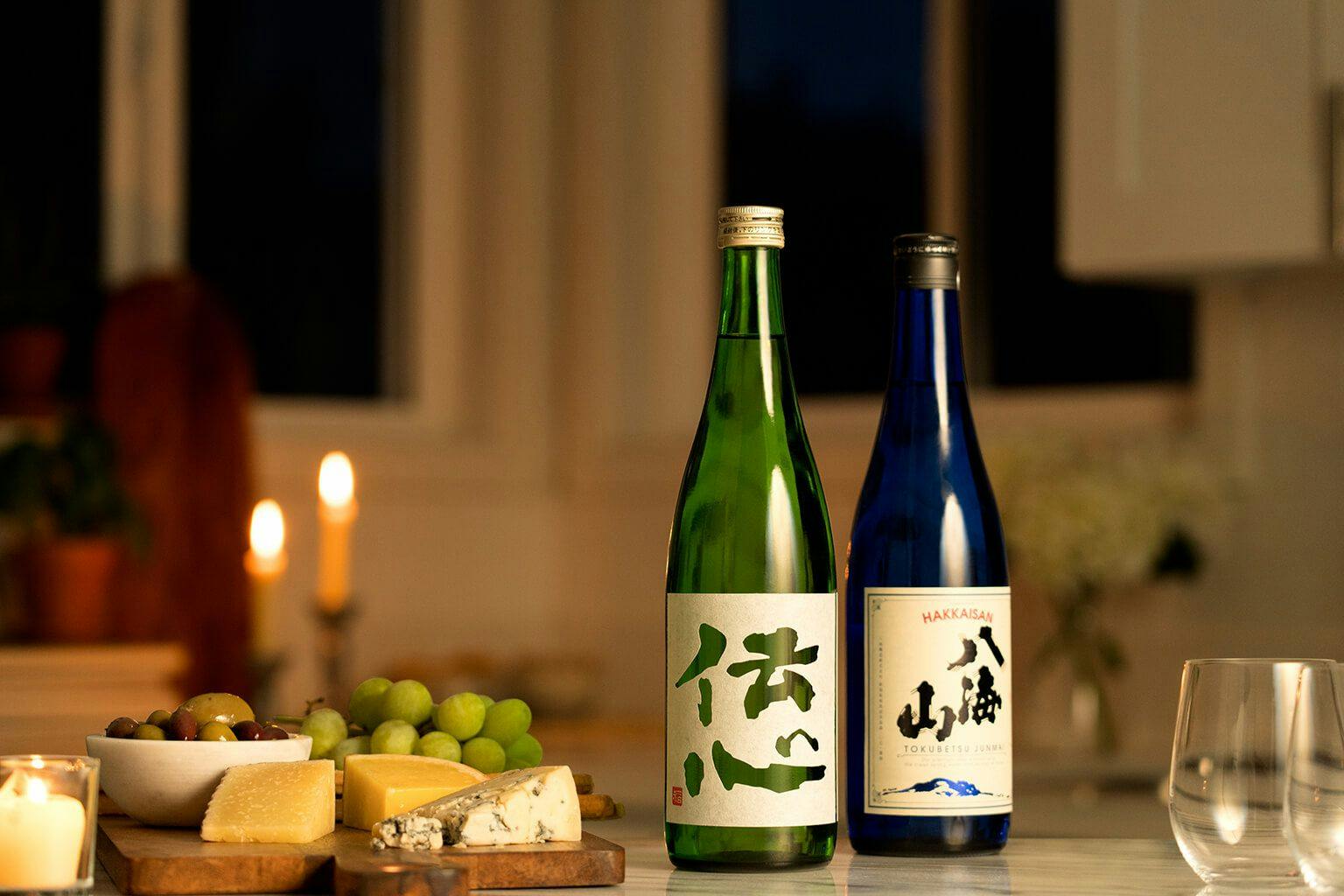Calories in Sake: Is Sake Fattening?
Table of Contents
Is sake fattening? It’s difficult to know with certainty how many calories are in any given bottle of sake. Unlike food, alcohol labels are not required to divulge this information. But what we can do is consult a few sources on the topic of sake calories and try to make sense of the data. We’ll also give you some tips about ways to avoid racking up calories while drinking, but still enjoy sake and have a good time.
For a more comprehensive review of the nutritional facts and health benefits of sake, check out our article “Is Sake Good or Bad For You? Sake Health Benefits.”
How many calories are in sake?
Different sources report different numbers when it comes to sake calories and nutrition, and every bottle of sake is different. The USDA says that there are 134 calories per 100 grams (or 100 milliliters) of sake. Japan’s National Research Institute of Brewing, and Japan Sake and Shochu Makers Association clock it at about 105 calories. Gekkeikan Sake, one of the most popular sake brands in the United States, asserts that 100 milliliters of their Gekkeikan Traditional Sake contains 108 calories. Takara Sake states that their Sho Chiku Bai Classic sake contains 30 calories per 30 milliliters, which translates to 100 calories per 100 milliliters.
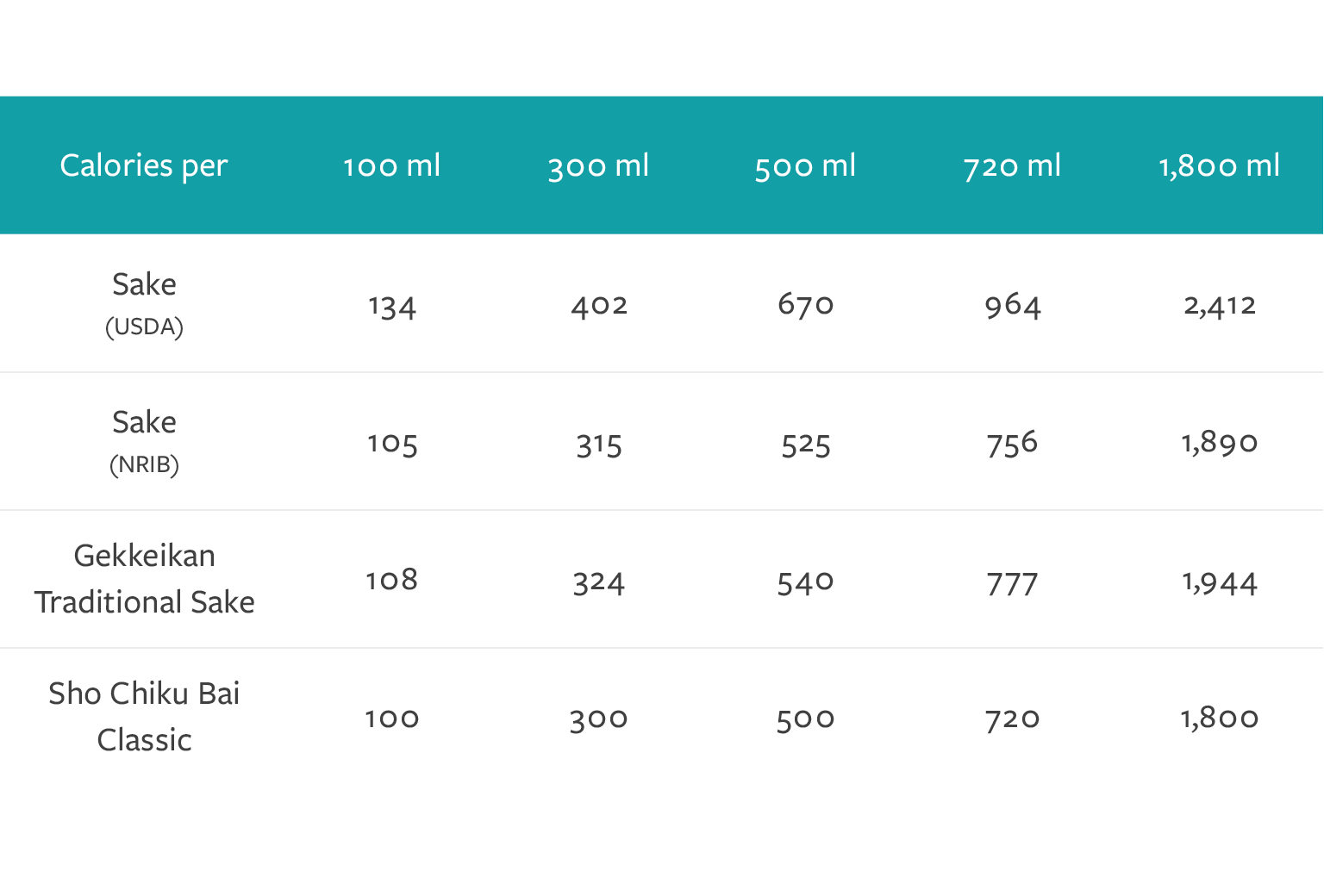
Now, you probably shouldn’t drink an entire bottle of sake by yourself in one sitting, but we’ll give you the numbers for that too. Sake bottles come in various sizes, typically ranging from 300 milliliters to 1.8 liters. The average sake bottle contains 720 milliliters of sake, which would be approximately 964 calories per bottle using the USDA value.
The Dietary Guidelines for Americans (2020-2025) says the daily calorie intake for women should range from 1,600 to 2,400 calories, while the range for men is between 2,000 and 3,000 calories. This resource also advises that healthy alcohol consumption for women is one drink or less per day; for men, it’s two. Essentially, as long as you moderate your alcohol intake, there’s no reason why sake can’t be part of a healthy diet.
Calories in sake vs. wine, beer and whiskey
For comparison, the USDA reports that the average white wine contains about 82 calories per 100 grams. The average beer contains 43 calories, and whiskey contains 231 calories. Most of the calories come from alcohol, which is why distilled spirits such as whiskey are more calorie dense than fermented beverages such as sake. Take a look at the chart below for a more in-depth comparison of sake, white wine, beer and whiskey.
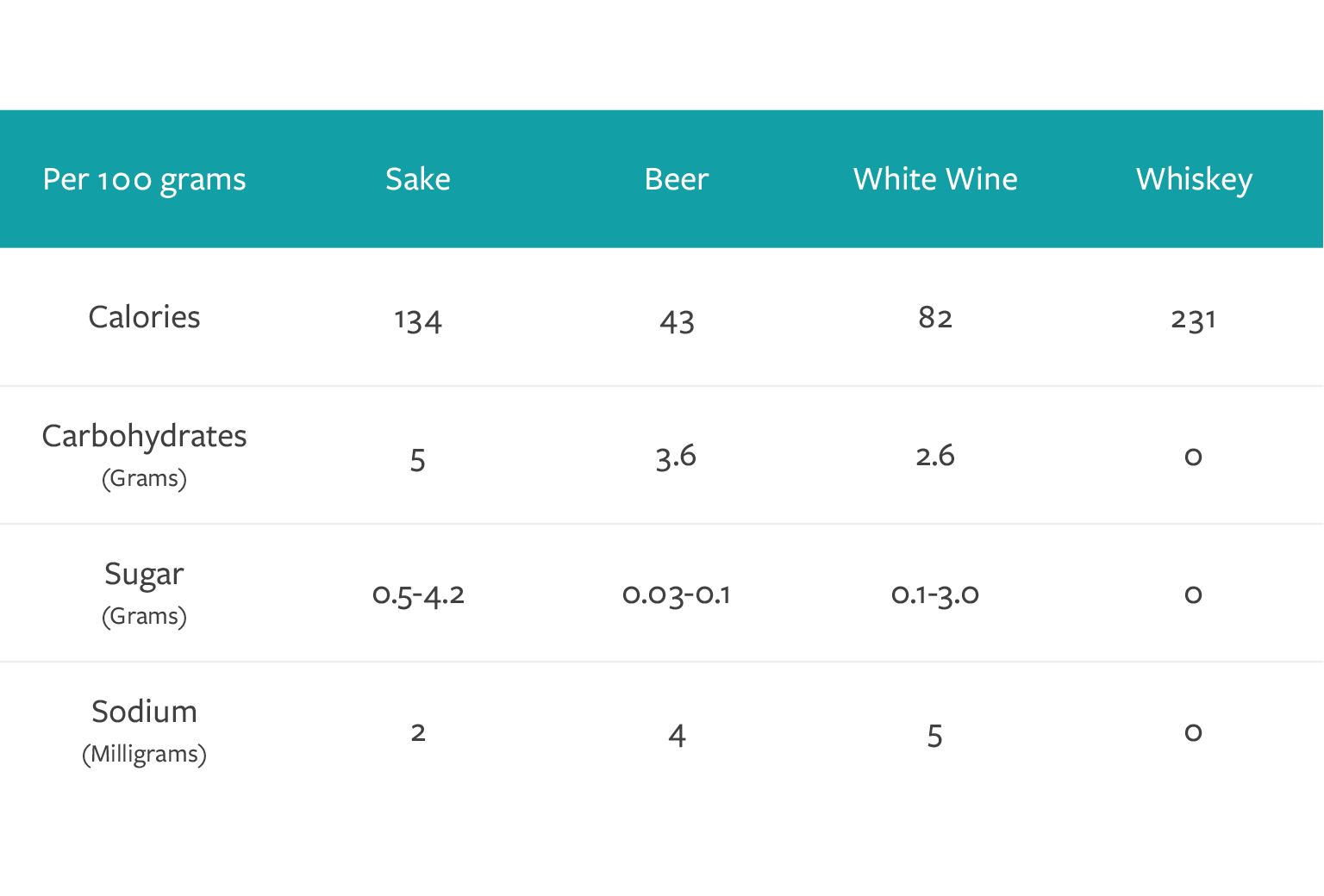
But people don’t generally measure 100 grams of alcohol every time they drink, so we’ve also designed a chart showing values adjusted for typical pour size:
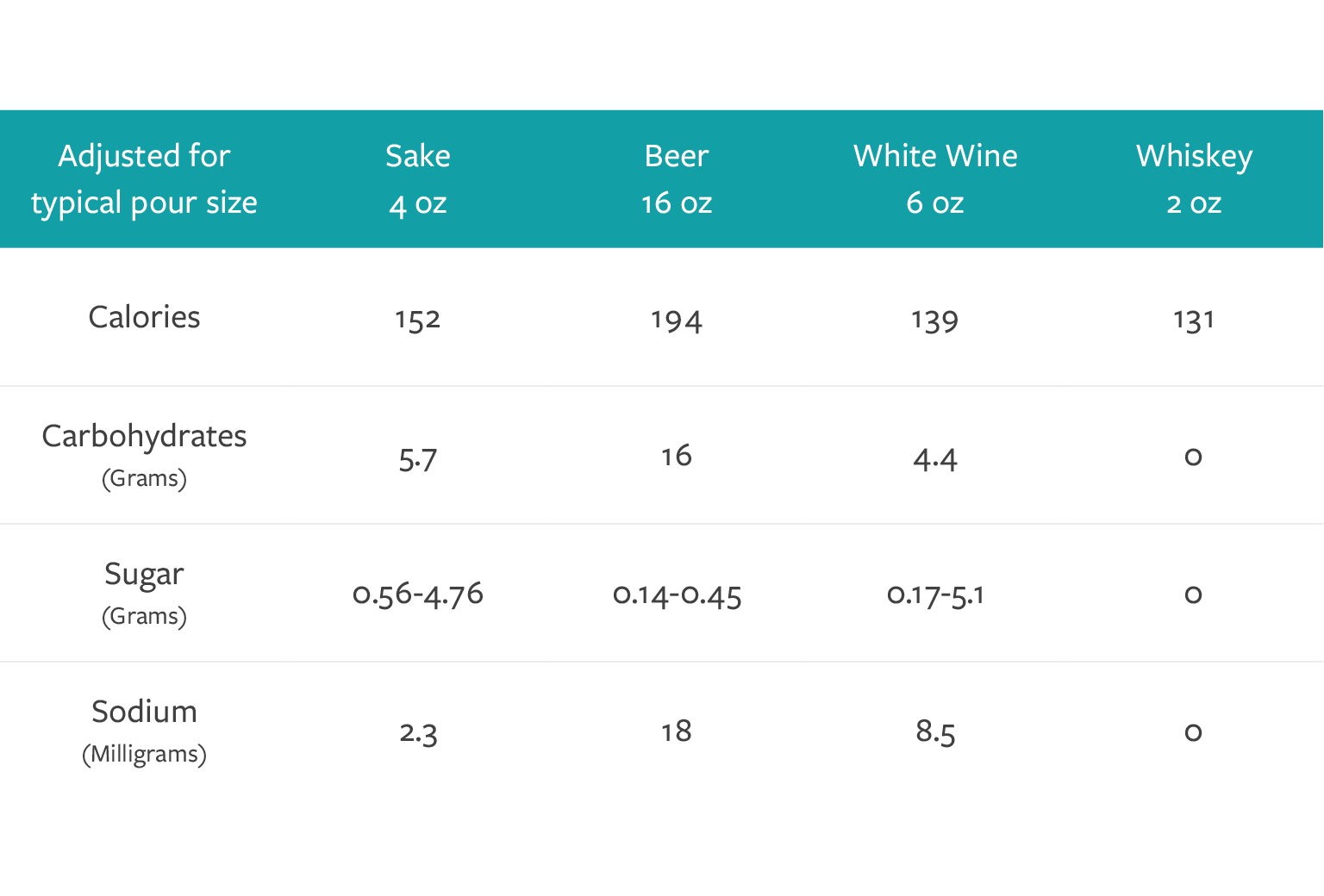
Comparatively, sake contains more calories than white wine and whiskey per average pour, but fewer calories than a 16-ounce glass of beer. How much you imbibe is just as important as how many calories the drink itself contains.
Sake calories by sake type
If sake calories are different for each bottle, the natural follow-up question to ask is, “Well, which sake types have more calories?” There are no hard and fast rules to live by when it comes to sake calories by category, but we can look at a few general truths for alcohol across the board.
On the whole, drinks with more alcohol content contain more calories. Most of the calories in sake come from its alcohol content. As depicted in the above chart, whiskey (minimum 40% ABV) has about 100 more calories per 100 grams as compared to sake (average 15%-16% ABV). The average ABV for wine is 12%, and the average ABV for beer is 5%. Based on these numbers alone, you can see why sake contains more calories than other non-distilled alcoholic beverages.
It follows that if you’re trying to find a sake that’s lower in calories, lower ABV sake is the way to go. “Genshu,” or undiluted sake, has the highest alcohol content out of all sake types. Legally, sake must have an alcohol percentage of less than 22%. Few sake go that high; the majority of genshu sake sits between 17% and 20% ABV. If you’re really watching your calorie intake, then maybe you don’t want to select a genshu sake. But again, drinking sake — or any alcohol — in moderation is what matters most.
Another thing to keep in mind is calories from sugar. However, it’s not as simple as just assuming that all sweet sake has more calories than all dry sake. In alcoholic beverages, the majority of calories come from the alcohol itself (7 calories per gram). Sugar provides 4 calories per gram. So a very sweet sake with a high ABV will contain more calories than a dry sake with a low ABV. On the other hand, a sweet sake with low ABV may contain fewer calories than a dry sake with a higher ABV.
Furthermore, sweet sake tends to have less alcohol content than dry sake, since strong alcohol flavor would take away from the sweet taste. Shirakabegura “Mio,” for instance, is a sweet sparkling sake with juicy notes of grape and pear, and it is only 5% ABV. Hakutsuru “Sayuri,” one of our bestselling nigori sake, is 12.5% ABV. As you can see, it’s really a case by case situation!
Are sake calories empty calories?
You may have heard people describe calories from alcohol as empty calories. But what does that mean? Empty calories are so called because they lack essential nutrients, like minerals and vitamins. Think of junk foods with high sugar, like soda and donuts. Basically, empty calories are found in a lot of substances that are extremely delicious and enjoyable, but not nutritious. Alcohol often falls under that umbrella.
Luckily, empty calories are quickly digested by the body, so unless you over-indulge, calories from alcohol alone aren’t enough to completely wreck your diet; alcohol just isn’t as nutritious as a kale salad, which you already knew. So does that mean sake is bad for you, and has no good health benefits? Not necessarily! Some studies have found that there are potential upsides for gut health and skincare. Take a look at our article on the benefits of sake to learn more.
5 tips to lower the calories
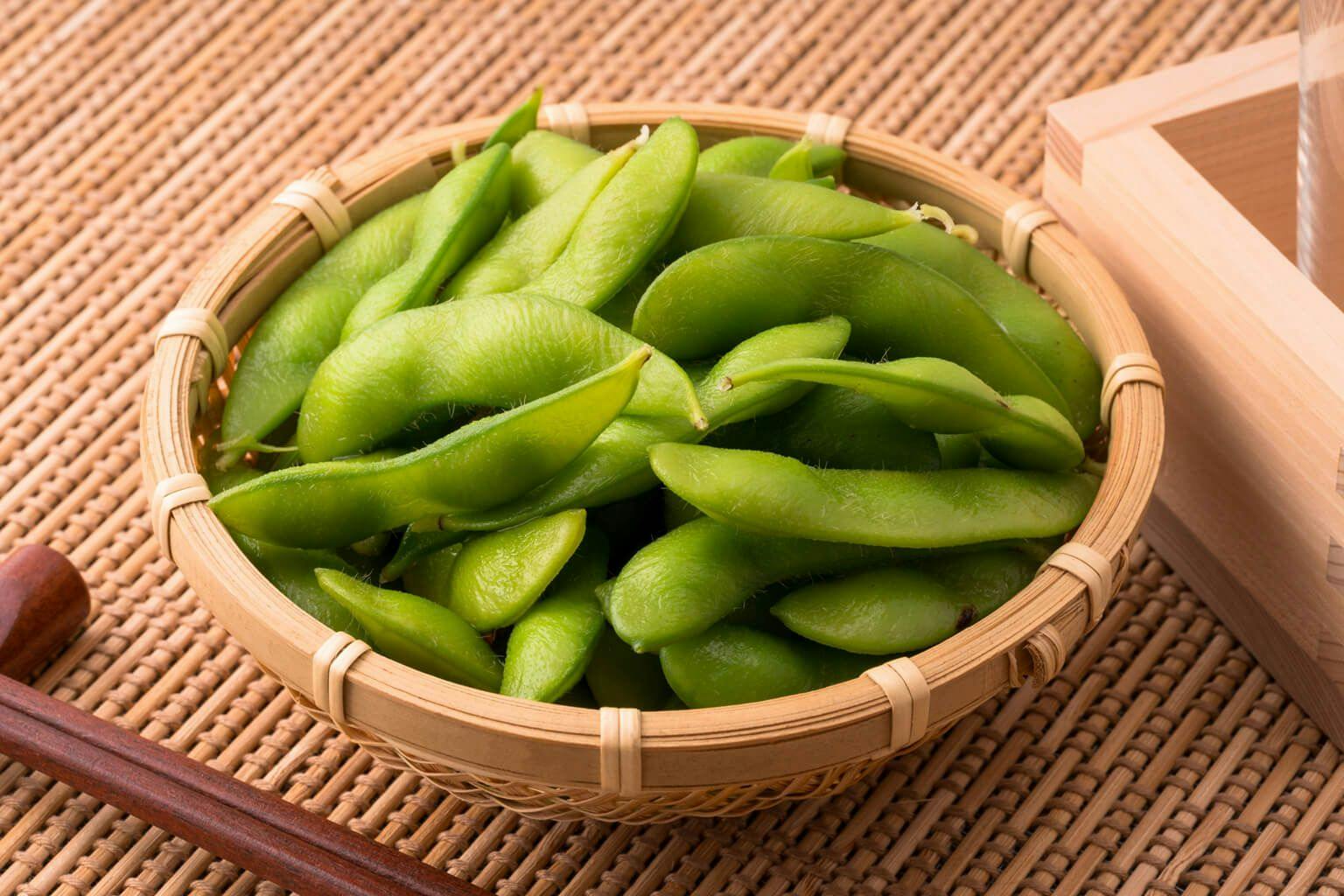
Alcohol unavoidably has calories, but if you’re going to drink — which we love to do — there are a few ways to try to curb your calorie consumption.
Choose snacks wisely
While there are calories in sake, more calories tend to come from snacking when you’re tipsy. Sake is full of umami, which pairs well with other savory foods, including salty snacks. But instead of reaching for a bag of potato chips, try a bowl of lightly salted edamame or nuts instead. You can also get a little creative with a charcuterie board favorite: prosciutto-wrapped cantaloupe. This snack is both sweet and salty, which would be a fantastic pairing with a fruity, light, slightly dry sake like Dassai.
Eat before you drink
It’s always a good idea to eat a full meal prior to drinking. If you feel full, you’re less likely to drink too much and also less likely to snack when you do drink. Not to mention, drinking on an empty stomach can make you sick!
Drink water
Staying hydrated isn’t just a good way to avoid hangovers; it also helps to pace yourself when you imbibe. The more you drink, the lower your inhibitions, and the lower your inhibitions, the more you want things and care less about negative consequences. Drink at least one glass of water for every glass of sake you drink to keep yourself in check.
Drink with smaller cups
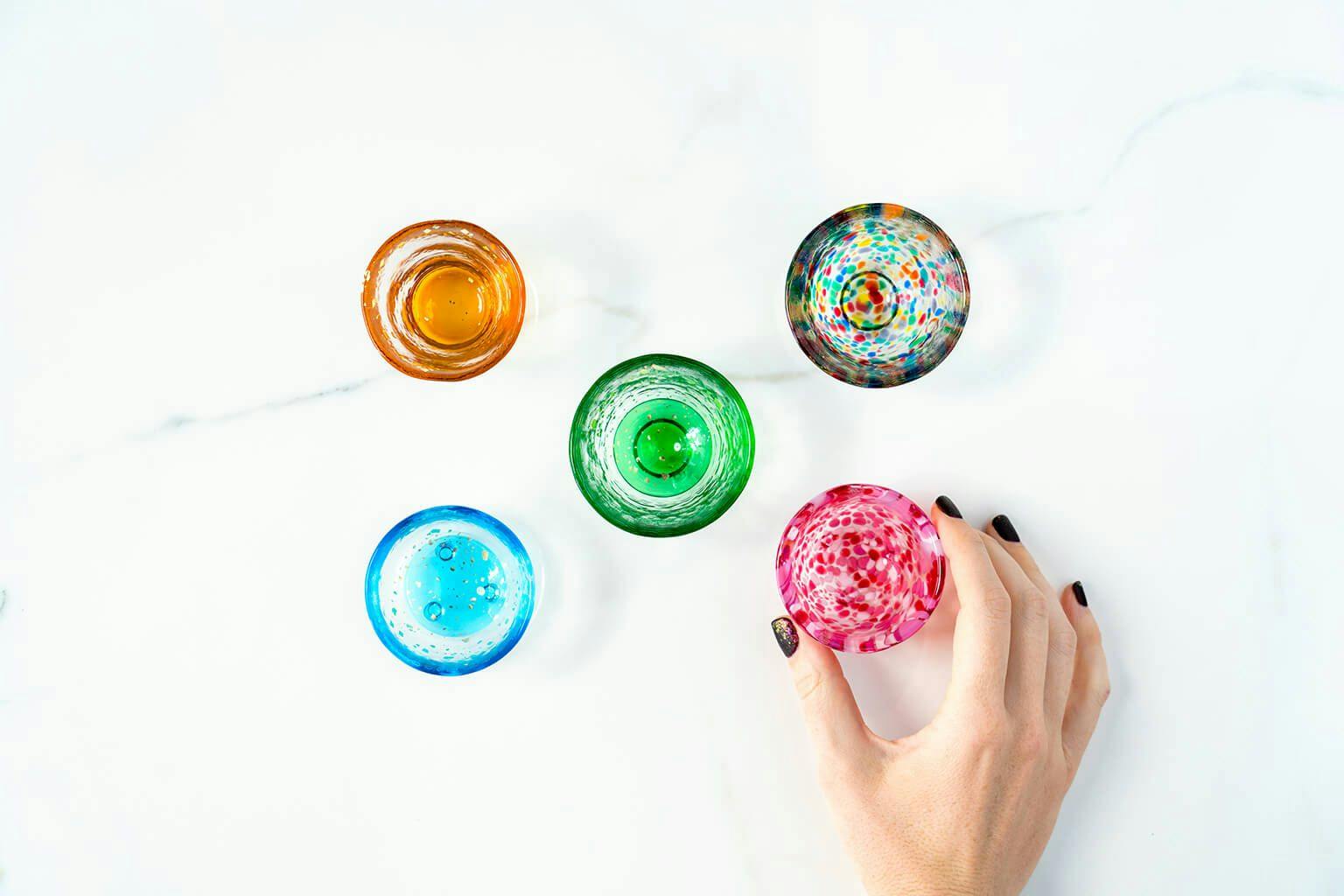
Sometimes you have to trick yourself. If you fill up a big plate with food, you’re tempted to finish the whole plate. But if you fill up a smaller plate and finish it, you can still feel like you had enough to eat even if it’s not as big a portion. The same kind of mind games can be useful when drinking sake.
Luckily, sake is known for its small cups! While plenty of sake can be enjoyed in a wine glass, choosing a small “ochoko” or “guinomi” cup can help you limit your alcohol intake. The repeated act of having to fill your cup can make you stop and think about how much you really want to drink.
Choose dry sake with less alcohol content
As mentioned earlier, it isn’t required for alcohol to feature labels with nutritional information. But based on the facts we’ve discussed, you can make educated choices about which sake you drink if you want to be cautious about sake calories. Opt for dry sake with less alcohol content.
HEAVENSAKE “Konishi” Junmai 12
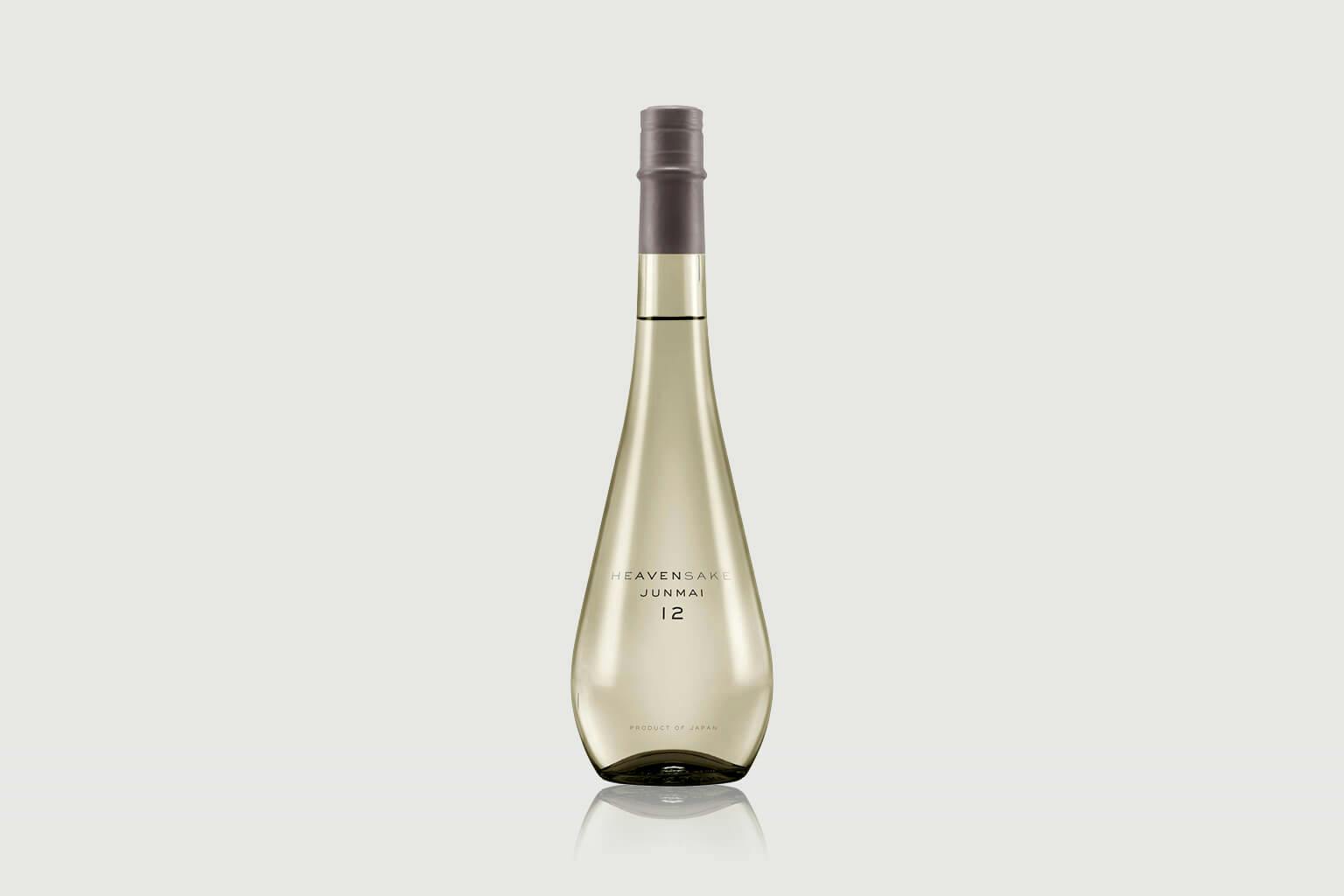
While the average sake ABV is 15%-16%, this smooth, nutty junmai is 12%. This sake is the result of blending various sake batches with different properties. It’s a unique collaboration between HEAVENSAKE’s Regis Camus, who has years of experience using this assemblage technique in the Champagne world, and Konishi Brewing Company.
Fukucho “Seaside”
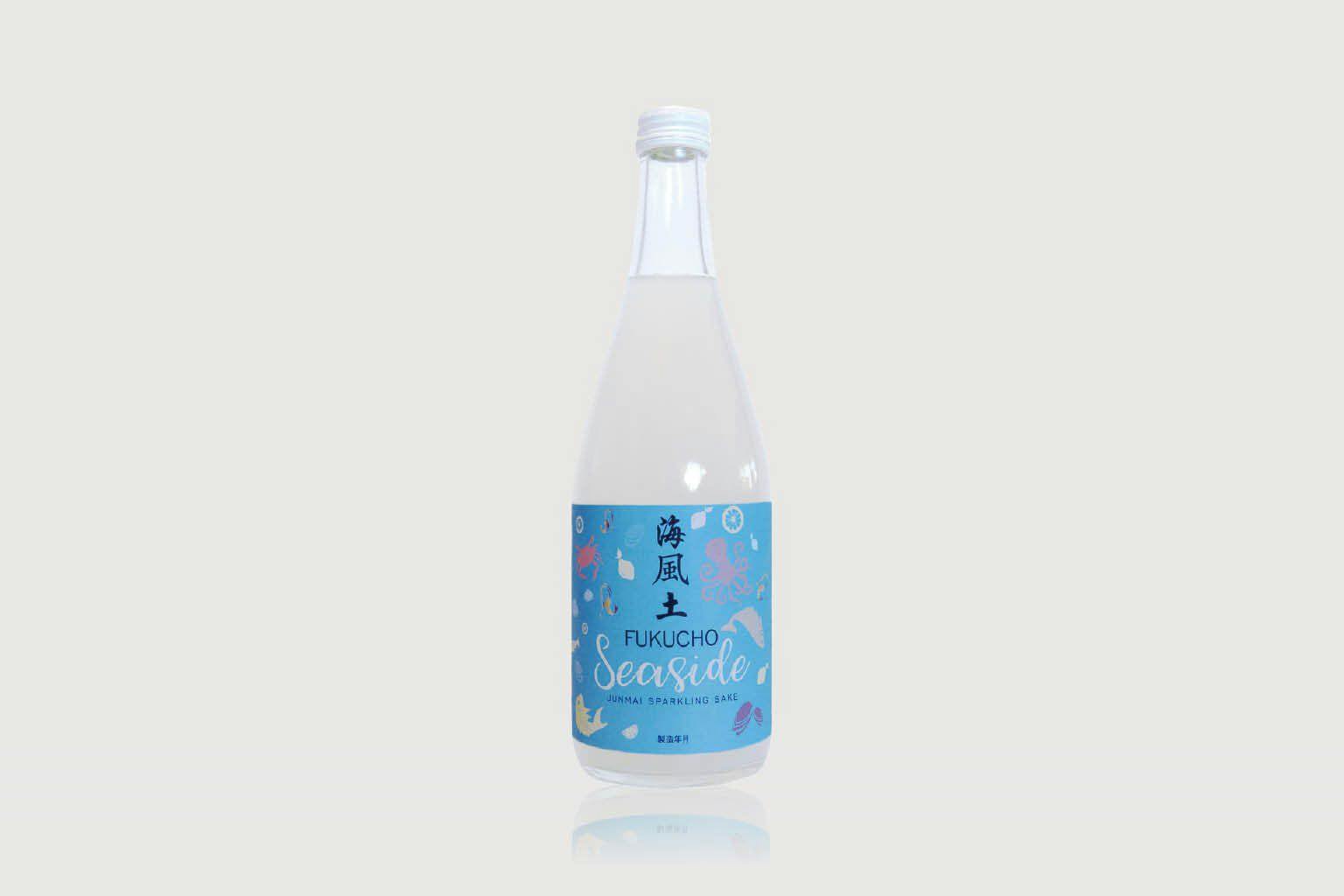
Imada Brewing Company’s Fukucho “Seaside” is 13% ABV. It’s a surprisingly low ABV percentage given that this sparkling sake is also a genshu. But a lot of its flavor comes from the use of white koji, which gives this sake a citrus-forward taste. The acidity of “Seaside” means it pairs well with seafood. Serve it with a plate of fresh oysters, which, by the way, are low in calories and high in nutrients!
WAKAZE “Classic”

WAKAZE France is another trailblazing sake brewery, and their “Classic” is 13% ABV. Brewed under the banner, “Mastered in Japan, made in France,” this junmai is made using ingredients sourced locally in France. The combination of white koji and wine yeast give this sake a white wine-like acidity and overall impression.
Drink smart, but have fun!
To some, that may sound like a contradictory statement, but trust us, it’s not! For those of us who love alcohol, drinking in moderation is the best way to maintain a healthy lifestyle. By keeping these tips in mind, you can partake of Japan’s inspiring national beverage without feeling guilty. Now go twist open a bottle with a friend, and kampai to your health and happiness!
Resources
Ariane Lang, BSc, MBA and Spritzler, F. Medically reviewed by Amy Richter, RD, Nutrition. “29 Healthy Snacks That Can Help You Lose Weight.” May 4, 2023.
https://www.healthline.com/nutrition/29-healthy-snacks-for-weight-loss
Drayer, L. “Which alcoholic beverages are more diet-friendly?” CNN. November 9, 2018.
https://www.cnn.com/2018/11/09/health/alcohol-diet-food-drayer/index.html
McCallum, K. “Empty Calories: What Are They & Which Foods Are They Hiding In?” Houston Methodist. Jan. 21, 2021.
https://www.houstonmethodist.org/blog/articles/2021/jan/empty-calories-what-are-they-and-which-foods-are-they-hiding-in/
Richards, L. Medically reviewed by Amy Richter, RD, Nutrition. “Everything you need to know about empty calories.” Medical News Today. Sept. 19, 2023.
https://www.medicalnewstoday.com/articles/empty-calories
“Sake 101.” Gekkeikan Sake USA, Inc.
https://gekkeikan.com/sake-101/
“Sake 101.” Takara Sake USA, Inc.
https://www.takarasake.com/about-sake/sake-101
“Dietary Guidelines for Americans, 2020-2025.” U.S. Department of Agriculture and U.S. Department of Health and Human Services. 9th Edition. December 2020.
https://www.dietaryguidelines.gov/sites/default/files/2020-12/Dietary_Guidelines_for_Americans_2020-2025.pdf
“Wine: From the Lightest to the Strongest.” Wine Folly.
https://winefolly.com/tips/the-lightest-to-the-strongest-wine/
“Standard Drink Sizes.” Binghamton University State University of New York. April 21, 2023.
https://www.binghamton.edu/hpps/atod/student-safety/standarddrink.html
“Do Sweet Wines Have Highest Calorie Count? Wine Myth Debunked.” Vivino.
https://www.vivino.com/wine-news/do-sweet-wines-have-highest-calorie-count-wine-myth-debunked

Taylor Markarian
Taylor Markarian is a culture journalist whose work spans the food and beverage, entertainment and travel industries. She is passionate about world travel and learning about different lifestyles and subcultures across the globe. Markarian is also the author of “From the Basement: A History of Emo Music and How It Changed Society” (Mango Publishing, 2019). Explore her work by visiting her portfolio.
Learn about Tippsy’s Editorial process
Recent posts
All about sake
Sign up to receive special offers and sake inspiration!
